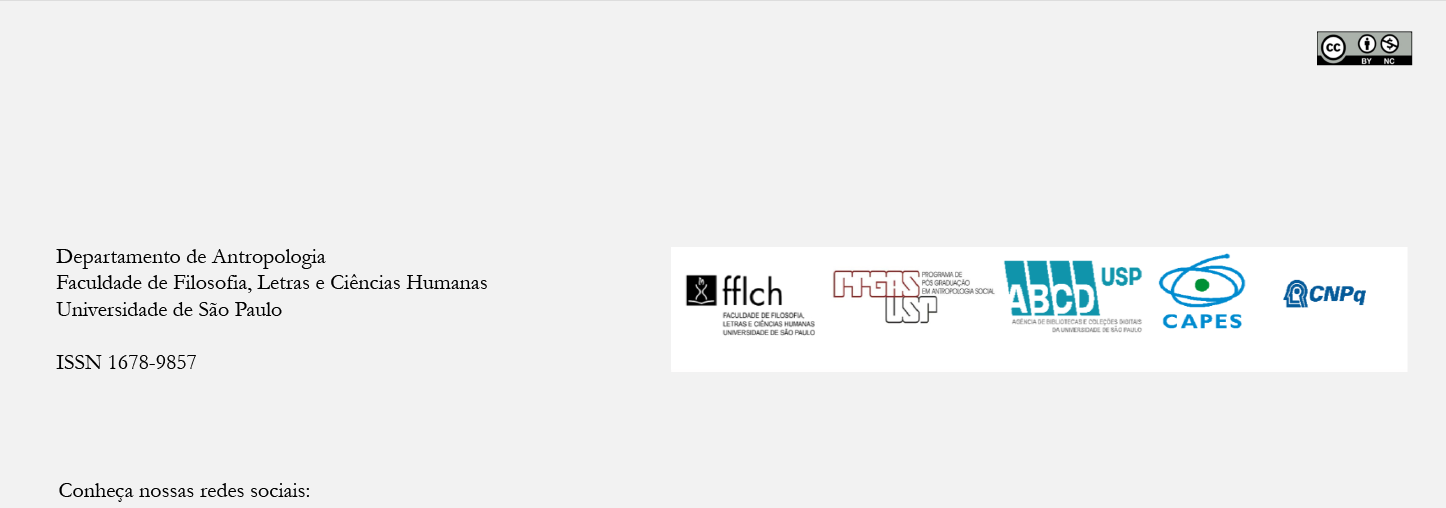A vida dos maracás: reflexões em torno de um instrumento ritual entre os Pumé da Venezuela
DOI:
https://doi.org/10.11606/2179-0892.ra.2016.116916Palavras-chave:
Maracás, seres humanos, seres vivos, pessoa, artefatos, ritual.Resumo
A partir da apresentação de alguns episódios da biografia de um maracá e dos laços que se estabelecem, no momento da passagem para a idade adulta, entre cada homem pumé e seu maracá, este texto apresenta diferentes ideias para se pensar as relações entre os seres humanos e alguns objetos. Neste caso, podemos falar de uma identidade entre um ser humano e um maracá. Esta equivalência está apoiada na ideia de que o corpo é um recipiente oco que deve ser fabricado e sustentado para poder acolher as essências vitais que permitem viver, quer os homens, os animais, os deuses e espíritos, as plantas e mesmo os objetos.Downloads
Referências
FORTIS, Paolo. 2014. “Artefacts and Bodies among Kuna People from Panama”. In HALLMAN, Elizabeth & INGOLD, Tim (orgs.), Making and Growing: Anthropological Studies of Organisms and Artefacts. UK, Ashgate, pp. 89-106.
HUGH-JONES, Stephen. 2009. “The Fabricated Body: Objects and Ancestors in Northwest Amazonia”. In SANTOS-GRANERO, Fernando (org.), The Occult Life of Things: Native Amazonian Theories of Materiality and Personhood. Tucson, The University of Arizona Press, pp. 33-59.
KOPYTOFF, Igor. 1986. “The Cultural Biography of Things: Commoditization as Process”. In APPADURAI, Arjun (org.), The Social Life of Things: Commodities in Cultural Perspective. Cambridge, Cambridge University Press, pp. 64-91.
LAGROU, Els. 2009. “The Crystallized Memory of Artifacts: A Reflection on Agency and Alterity in Cashinahua Image-Making”. In SANTOS-GRANERO, Fernando (org.), The Occult Life of Things: Native Amazonian Theories of Materiality and Personhood. Tucson, The University of Arizona Press, pp. 192-213.
OROBITG, Gemma. 1998. Les Pumé et leurs rêves: Étude d’un groupe indien des Plaines du Venezuela. Amsterdam, Éditions des Archives Contemparaines (Ordres Sociaux).
PERTULLO, Vincenzo. 1939. “The Yaruros of the Capanaparo River, Venezuela”. Anthropological Papers, n. 11. Washington D.C., Smithsonian Institution. Bureau of American Ethnology. Bulletin 123.
SANTOS-GRANERO, Fernando (org.). 2009. The Occult Life of Things: Native Amazonian Theories of Materiality and Personhood. Tucson, The University of Arizona Press.
VANDER VELDEN, Felipe. 2011. “As flechas perigosas: notas sobre uma perspectiva indígena da circulação mercantil de artefatos”. Revista de Antropologia, Sao Paulo, 5(1): 231-267.
VELTHEM, Lúcia Hussak van. 2009. “Mulheres de cera, argila e arumã: princípios criativos e fabricação material entre os Wayana”. Mana 15(1): 213-236.
VIVEIROS DE CASTRO, Eduardo. 2012. “Cosmological Perspectivism in Amazonia and Elsewhwere”. Master Class Series 1. Manchester. HAU Network of Ethnographic Theory.
WALKER, Harry. 2009. “Baby Hammocks and Stone Bowls: Urarina Technologies of Companionship and Subjection”. In SANTOS-GRANERO, Fernando (ed.) The Occult Life of Things: Native Amazonian Theories of Materiality and Personhood. Tucson, The University of Arizona Press: 81-103.
Downloads
Publicado
Edição
Seção
Licença
Copyright (c) 2016 Revista de Antropologia

Este trabalho está licenciado sob uma licença Creative Commons Attribution 4.0 International License.
Autores que publicam na Revista de Antropologia concordam com os seguintes termos:
a) Autores mantém os direitos autorais e concedem à revista o direito de primeira publicação, com o trabalho simultaneamente licenciado sob a Licença Creative Commons Attribution que permite o compartilhamento do trabalho com reconhecimento da autoria e publicação inicial nesta revista.
b) Autores têm autorização para assumir contratos adicionais separadamente, para distribuição não-exclusiva da versão do trabalho publicada nesta revista (ex.: publicar em repositório institucional ou como capítulo de livro), com reconhecimento de autoria e publicação inicial nesta revista.
c) Autores têm permissão e são estimulados a publicar e distribuir seu trabalho online (ex.: em repositórios institucionais ou na sua página pessoal) após o processo editorial, já que isso pode gerar alterações produtivas, bem como aumentar o impacto e a citação do trabalho publicado (Veja O Efeito do Acesso Livre).



